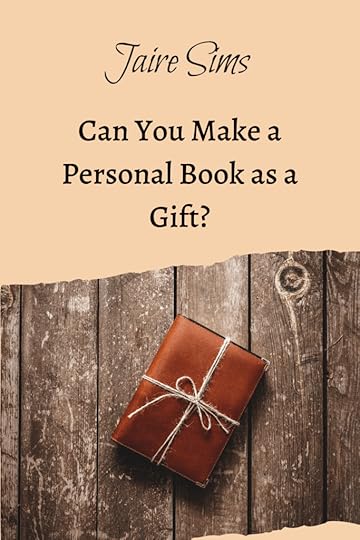Jaire Sims's Blog, page 4
May 16, 2023
Coming of Age and Young Adult Fiction Are The Same, Right? Let’s Find Out
When you look at the target age of your average young adult fiction (YA) reader, it makes sense that many of the stories they read feature the classic coming-of-age journey. Our teen years mark some of the first steps into adulthood, and reading about it in books is a fantastic way for 12-18-year-olds to learn about themselves and the changes they’re undergoing. So does that mean all YA fiction books are coming-of-age novels?
To Come of Age
When it comes to novels, coming of age is a theme. The concept itself marks a time in a character’s life when they’re undergoing a significant change or moment of growth, transitioning into the next phase of their life, whatever that is.
So obviously, that applies to the YA audience, but there are many other examples of moments when people can come of age at any age:
Starting their dream jobComing outDiscovering their purpose in lifeBooks for Young Adults
Novels for the YA reader can encompass a variety of themes or genres.
Typically written from a first-person perspective, they focus chiefly on the protagonist, run somewhere between 45,000 to 85,000 words in length (unless they’re sci-fi or fantasy, which creep a bit higher), deal with lighter subject matter, and use more youthful (for lack of a better term) prose throughout.
Though coming of age is a common theme in YA, it does not define the format.
So, There IS a Difference
Plenty of books outside the YA category include coming-of-age stories. It’s not exclusive to the teenage journey, as I mentioned above. The distinction ultimately is in the structure of the individual novel.
If it doesn’t fall within the traditional format of a YA book, then it’s just a coming-of-age story as opposed to a young adult coming-of-age story. Adult books will tackle the theme with, well, adult problems, heavier subject matter, more words, at a slower pace, and may be in the third person point-of-view.
Understanding the distinction between the genre or theme of your book and its structure will make you a better writer and help you strategize the outline of your novel. If you intend to write a YA coming-of-age story, you need to pay attention to the hallmarks of writing young adult fiction rather than what goes into the theme.
If you find that your manuscript is escaping those confines, then it isn’t meant for the YA audience after all! My first novel, Getting By, made sense as a YA novel and deals with some coming-of-age themes. But in my follow-up, my character is getting older and dealing with more adult problems, so there will be a shift in structure this time.
In some ways, my career as an author is having its own coming-of-age transformation right now! If you’re writing your YA novel and have questions about the structure or anything else, I welcome you to reach out and find me on social media.
The post Coming of Age and Young Adult Fiction Are The Same, Right? Let’s Find Out appeared first on Jaire Sims.
May 9, 2023
Publishing Your YA Novel: Should You Get an Agent?
When it comes to publishing, there are two basic schools of thought: traditional and independent. As you wrap up your manuscript revisions, you’re likely starting to think about how you want to share your story with the world.
I wanted to take control of my YA book’s journey, so I went the self-publishing route, choosing to get my novel out there independently. But it takes a lot of work. Some would rather have a professional handle that, which is where a publisher comes into play with the traditional model.
However, finding a publisher also takes a lot of effort, and that’s where a literary agent comes in. But that doesn’t mean you need one.
A Big DIY Project
The most obvious way to circumvent the need for an agent is to publish independently. Before the advent of the internet, self-publishing was a massive challenge.
Now, it’s never been easier when there are a variety of websites and places like Amazon’s Kindle Direct Publishing around for anyone to access. But what you need to be aware of is the workload and costs involved.
When you go independent, you shoulder the entire financial burden of hiring an editor, getting a cover art design, and marketing the novel in hopes of getting it onto more shelves. Getting readers looking at your YA book over others is a constant hustle.
Now, some businesses, like BookBaby, who I self-published with, do provide extensive services as part of their costs, so that can help alleviate stress, but if you’re not ready to pay for that, then you’ll need to be prepared to work to fill in the blanks on your self-publishing journey.
What Does An Agent Do?
But maybe you’d like to take a chance with traditional publishing and let a big publishing house handle the finer points of delivering your YA book. What exactly would a literary agent do to help you with that? Here are the broad strokes of what you can expect:
RelationshipsAn agent’s job is to know who to talk to with the big publishers of the world. Because they’ve been developing those relationships, they make it easier for an author’s work to get in front of the right eye.
Simultaneously, they’re helping build your relationship with those publishers, especially when you get signed. Many writers prefer to avoid being bogged down by constant back and forth with publishers when they’re trying to write, so your agent can take care of that for you.
Making the DealsAgents will secure the best deal for their clients. Because the less money you make, the less they make. So you can always count on them to help you navigate contracts and agreements to achieve the best outcome for you and your story. That means movie or tv rights, tapping into foreign markets, and everything in between, which can sum up to a lot of paperwork.
Knowing What SellsIf your idea of success as an author is fame and fortune, then an agent can help navigate the ever-changing YA marketplace. They keep up-to-date on trends and will know the best way to slot your book into the zeitgeist. From finding the best editor for the genre to helping you pitch to publishing houses, agents want to help you sell, sell, sell.
Traditional Publishing
With all that said, can you secure a deal with a traditional publisher without the help of a literary agent? The short answer is “yes.” The longer version is that it will be a lot more challenging and, at times, heartbreaking to try and get into a large publishing house without an agent’s help.
Anyone can reach out to publishers, pitch their work, navigate contracts, and all the other finer points. And if that appeals to you, then I encourage you to go for it. But if it’s at all daunting, you’d likely be best served signing with a literary agent. It’s their job to be experts in the field, making it easier for authors to focus on their expertise and not sweat the details.
So if you want to hook a traditional publishing deal, make sure you review everything involved before committing to that journey before getting in over your head.
As an author, you have some power over how your book gets shared with the world. Some routes are easier than others, but it’s always possible to handle everything yourself. A literary agent is optional, thankfully, though having one would help if you want to get picked up by a major publisher.
Alternatively, if you’re like me and want total control of when your book gets published, then self-publishing is the way to go. And even then, that’s a learning curve all on its own!
But you can check out my free self-publishing guide to avoid the mistakes I made along the way and ensure your novel comes out in less than the 10 years it took me to write and publish Getting By!
If you have further questions about publishing your young adult novel, feel free to get in touch or find me on social media.
The post Publishing Your YA Novel: Should You Get an Agent? appeared first on Jaire Sims.
May 2, 2023
As a Teenager, What Are Some Good Ideas for Novel Writing?
Teens have a lot going on in their lives. Sure, they likely haven’t started their career nor own a house, or (hopefully) aren’t raising children yet, but it’s a massive stage in life.
Our teenage years start to see us shaped into the adults we will likely become as we navigate complex emotions, commit to our passions, and explore ourselves in various ways that are often frightening, confusing, thrilling, and joyful.
While some adults like to reminisce on those carefree days, others are equally glad to be done with the mess of the learning curve we experience in our teens. If you’re a teenager navigating all that and looking for a place to express yourself, you can learn to write and even get published.
Some of the most famous novels, young adult (YA) and otherwise, were written by teens, like Eragon and Frankenstein and one of my favorites, The Outsiders. To help you get started, I have some great tips any budding author can apply when learning to write their first novel!
Practice Makes Mistakes
As a teenager, you have time to do almost anything. I know that we all have some responsibilities, and school is vital, but beyond that, your time is primarily your own in your teens.
So, if you’re serious about writing a book, you have the time to practice. Writing every day, whether on your manuscript or just something for fun to express an idea, will make you a better writer.
You will write good stuff, and, just as importantly, you will write terrible stuff. But the best thing about mistakes is that people generally learn from them and improve. Plus, you’ll be more likely to finish writing your book with regular practice. Try spending at least 20 minutes daily on writing and develop a healthy habit for your craft.
Resources Are There To Help
Don’t neglect the power of all those books on writing. Not everyone has great ideas every day or a natural gift for focus or writing. Sometimes we need help, and that’s okay! Because support is there!
When you’re struggling to practice every, pick up a book or find a website, like Reedsy, that provides prompts to help inspire your work. There are also a lot of great books that offer exercises and structure to help you, like Angie Thomas’ Find Your Voice.
There are enough obstacles to writing, so if you can surpass them, I highly recommend finding the right resource that speaks to your needs and making liberal use of it!
Start Writing Early
A lot of creatives thrive as night owls but can struggle with writer’s block. There’s a likely correlation between that and the fact that they’ve just spent a whole day expending their mental and physical energies and have nothing left to give to their projects.
That’s why I’ve seen a lot of people recommend writing in the morning. For a teen, that means before school, which, I KNOW, is early. But trust me: it’ll help you finish your story and wake your brain up for the day.
Because after a day of school, homework, extracurriculars, and possibly even your first job, you’re more likely to be burned out than if you woke up 30 minutes early every day to write for 20.
Accountability is Hard
It takes a lot of self-discipline to finish writing a novel. Some people naturally have that in them, but so many do not. At all. And that’s okay. Recognizing that struggle allows you to seek out help.
Joining a writing community of other authors sharing their work and encouraging progress is a great way to ensure you keep writing. You can also join a challenge, like NaNoWriMo, where you’re tasked to write 50,000 words in a month (plus, they have a lot of other great resources and challenges on their site!)
Or maybe you’re fortunate enough to know a published author who can mentor you. However you go about it, having something that holds you accountable to completing your task is an incredible way to support your writing.
Don’t Be Afraid to Set Things Aside
However, I don’t want to overwhelm you with all these tips! It’s been a lot of work, work, work (and writing certainly is a lot of that.) But sometimes, we must be honest with ourselves and step away from the craft for a bit.
Pursuing other hobbies and taking a breather will help you get perspective, reignite your passion for writing, and make you a more well-rounded human (which means you’ll be a more genuine author.)
Just because your brain, heart, soul, or whatever you want to call it needs a break doesn’t mean you’re a failure or not passionate enough — it’s natural and good for you, so honor that desire. Life needs balance, and you’ll never finish your story if you burn out on the process and lose your passion for it.
Publishing Is Important… But Not Yet!
Do you have a finished book yet? No? Okay, then stop worrying about publishing! You can’t publish what you don’t have, so wasting energy researching and worrying about the process and book signings and press tours won’t help you finish your novel any faster.
It’s a thrilling fantasy to muse on now and again, but until you finish your manuscript and send it to an editor, there’s no point in looking into publishing just yet.
Don’t Stop Your Reading
Keep the fires alive, and remember to make time for reading. I’ve said as much in other posts, but reading what you want to write is integral to being an author.
It will inspire you and keep you involved in what’s going on in the industry, what is popular, and where the gaps are (that you could fill with your work!). So when you take those breaks mentioned above, remember to make time for reading.
Writing a book is a daunting proposition. And as a teenager, with your whole life ahead of you and the weight of the world on your shoulders (so it feels like sometimes), finishing a manuscript seems all the more challenging.
But it doesn’t have to be! A little bit of discipline and mindfulness can go a long way to help you become the next famous teen on the list of YA authors! If you have questions about how you can help get started or are looking for tips and resources, check me out on social media or email me at jsims@jairesims.com.
The post As a Teenager, What Are Some Good Ideas for Novel Writing? appeared first on Jaire Sims.
April 25, 2023
6 Pitfalls to Avoid When Writing a Young Adult Novel
I’ve been writing a lot lately about all the good components of writing a young adult (YA) novel. But if you’re going to learn how to write quality YA content, then it’s essential to consider the pitfalls in the process. There’s no way your book will sell if you fall into writing traps, so let’s talk about some thought processes you need to avoid so you can learn to write the best story possible.
Not Reading
“I’m too busy writing and don’t want to influence my work by reading other authors.”
If you’re writing for young adults, you must read what they’re reading. That will help you keep abreast of the zeitgeist to incorporate some trends while carefully forging your path. It also inspires the craft and enables you to become a better writer.
The more you read, the easier it is to identify quality writing from the poor, learn what suits your tastes, and see where you can improve on your inspirations. You can also extend this into TV, films, and games directed at the YA audience, though most of your efforts should focus on reading. You will only become a better writer by making space for reading YA.
Following Trends
“It’s not my thing, but zombies are in right now, so my novel will be about that!”
I know I just said it’s vital you be on top of the zeitgeist, but that doesn’t mean writing about the most popular content on the market. Eventually, it will become so inundated that no one will see your novel in the morass of trendy books. Also, if you’re not passionate about your writing, your readers will tell you’re going through the motions.
I suggest finding a happy middle ground, starting with what you’re excited to write about and seeing if the latest trends have a place in that. If they do, neat, but if not, that’s fine because you will write a better book about something you know well and care about instead of hoping that tapping into the popular trends will sell your manuscript.
No Conflict
“Life’s hard enough, so I want everyone in my story to be happy.”
Nobody wants conflict in life, but it happens anyway, so why avoid it in your story? Conflict builds tension and creates struggle, which is interesting to read. If there’s no conflict, then nothing will happen in your story.
Whether they admit it or not, people like drama to some extent, primarily because we all love the “will they or won’t they succeed” component involved. That’s what keeps readers turning pages, hoping that your protagonist will find some way to navigate their sources of conflict until the final confrontation presents the ultimate challenge.
Flat Characters
“My hero is angry at the world, so that’s what drives them!”
One-dimensional characters are bland and have nowhere to grow. If you write your protagonist with limited motivation, you are hamstringing yourself in the process. People are fully fleshed-out beings with attributes and flaws, hopes and fears, all of which govern their raison d’etre.
Before you start your writing, really dig into what makes your protagonist and the other main characters tick, so you can build a compelling arc that you know readers will want to follow from start to finish.
Content for Content’s Sake
“I wrote this because it sounded cool.”
Hopefully, you’ve heard the phrase, “Kill your darlings.” It means editing out even the most favorite parts of your work. Your novel needs to stay relevant to the story. So, as you approach scenes and dialog, always ask if it’s necessary to the book’s trajectory.
You could write the most beautiful piece of prose or have the most fantastic setting in mind, but if it doesn’t move the story or your character’s growth forward, cut it. Your readers can tell if you didn’t need to write something and will feel like you’re wasting their time when there’s no payoff. Stick to what’s essential to your novel and trim the fat in your content.
Don’t Change a Thing
“I think my writing is perfect as it is.”
No one nails it on the first pass (I felt pretty good about this post until Grammarly suggested otherwise…). Writers must remember that and be comfortable receiving feedback and revising their work.
If your skin isn’t thick enough for constructive criticism, you may want to rethink this entire process. Running your manuscript by peers and editors is crucial if you ever want your novel to sell. And I know it can be hard to hear that something you thought was your best work may have missed the mark. But try to reframe your thinking that feedback can help your book become even better than you think it is.
Also, remember that it is your story, so you can pick and choose the changes you wish to implement (but again, you likely didn’t write the perfect story, so something will need adjusting!)
Writing is difficult at the best times, but thankfully, people like me have already bashed their heads against the wall. You’ll undoubtedly run into other issues as you go, but I hope these tips can help you avoid the more obvious problems as you learn to write your YA novel.
There isn’t an exact science to writing YA books, but keeping all the above in mind can nudge you closer to success. If you want more in-depth help by learning from my authorial journey, check out my course (and avoid taking 10 years to write your novel as I did!) I’m also open to the odd question on social media, or you can email me at jsims@jairesims.com.
The post 6 Pitfalls to Avoid When Writing a Young Adult Novel appeared first on Jaire Sims.
April 18, 2023
Writing for Young Adults? Here Are the Key Elements Your Story Needs
There is a particular recipe for writing young adult fiction and non-fiction. That’s not to say they’re formulaic, but that there are specific components you as an author need to include for your novel to be categorically young adult (YA). My last blog covered everything you should include, but certain elements appear more often than others.
Out of the Mouths of Teens
Teens talk a lot. I mean, this is a generalization, but it’s often the case. YA reflects that with more dialogue-heavy scenes than other novels. You still want to keep these conversations to the point, but there will be plenty of them throughout the story.
Authors also reflect how teens speak, which is often more impulsive, with less confidence (or sometimes overconfidence), lots of drama, and keeping it simple with grammar and vocabulary. All of that makes it more digestible and “real” for the readership.
It’s About the Teens/Young Adults
Whether the genre is horror, western, sci-fi, or epic fantasy, the story is still grounded in the reality of what it is to be a teenager or young adult. YA novels take the protagonist and the readers by proxy on a thrilling adventure that comes with lots of self-exploration.
The world and core dilemmas are merely a vehicle to instigate that growth. By maintaining realism, readers will identify with the story and characters all the better, keeping them turning pages and learning a bit more about themselves.
Showing Some Growth
No matter what lessons the protagonist takes or how the story ends, good or bad, they will learn something by the end of the novel, leaving them happy enough that readers are satisfied. Regardless of genre or theme, it is a universal truth across all young adult fiction and non-fiction.
But remember that whatever “lesson” you may have in your novel, you keep it subtle. If there’s anything teens dislike, it’s someone telling them overtly what to do or think, so successful authors avoid being preachy.
Diet Tough Subjects
Teens are not immune to the struggles many adults face, so most authors aren’t afraid to incorporate love, loss, death, sex, violence, and other challenging topics in their works. However, they often approach it delicately, providing a safe space for teens to tackle and process these difficult life factors.
YA novels are a brilliant vehicle to educate and encourage literacy, but also emotional intelligence and critical thinking surrounding major, life-moving subjects.
All of these elements make up the foundation of quality young adult fiction and non-fiction. Thankfully, they’re relatively straightforward to incorporate into your writing, regardless of what you write about.
Stay true to the story you want to tell while keeping the above in mind, and you’ll have readers clamoring for more! Reach out to me at jsims@jairesims.com and follow me on social media to ask me anything else about YA novels. I’ll be happy to hear from you.
The post Writing for Young Adults? Here Are the Key Elements Your Story Needs appeared first on Jaire Sims.
April 11, 2023
The Best Things to Consider When Writing a Young Adult Novel
When I began writing Getting By, I didn’t immediately decide on a genre, as I simply wanted to write a story centering on the experience of a male high school student. But in time, it became clear that Getting By was a Young Adult (YA) story because of its elements. So, if you’re planning on writing YA books yourself, here are a few guidelines to help you out with nailing the genre.
Readers Want to See Themselves in the Pages
First, you’ll want to focus on the age of the main character and the characters in their circle. YA protagonists tend to be 12-18 years of age, though this rule isn’t set in stone, as some novels deviate from this standard.
But YA will generally have a protagonist in their teens. And it’s okay for the story to contain adult characters, but they will never be the leads. No matter how well-developed those characters are, they will never be the ones whose fate is at stake in a YA story, as that won’t resonate with the target readership.
Adults in YA stories often serve different roles to the protagonists, such as an enemy, a leader, a guide, an obstacle, etc.: tertiary characters. Look at the main character for my book, Getting By, who starts as a 17-year-old junior. While there are adults in the story, my protagonist serves as the heart and lead.
Not Too Long, Not Too Short – Just Right
Another factor to consider is the word count. YA books typically have a word count between 45,000 to 85,000 words. Mine had at least 53,000 words when I published it.
While those grounded more in a modern reality setting sit at the lower end of the count, there’s an expectation for YA sci-fi and fantasy stories to have a higher count, ranging from 75,000 to 95,000 words. That’s because YA books that combine genres, such as fantasy, historical, sci-fi, and dystopian, typically have a higher word count due to their expansive plots and the world-building involved.
There’s wiggle room between those counts, regardless of what you’re writing about, but you’ll want to keep that in mind when it comes to publishing.
Look Who’s Talking
Teenagers act, think, speak, and experience things differently than adults, so your YA novel should reflect that with its tone and point of view. YA books also favor a style of storytelling where events occur at the present moment, keeping the story relevant.
They are also often told in close third-person (limited omniscience to one character) or first-person point of view, helping to keep the story focused and clearly illustrate the growth and journey of the protagonist, generally reflecting how most youths and teens fixate on themselves during that period of change.
I chose to use first-person with Getting By, letting the reader live vicariously through my protagonist’s eyes.
What Matters to Your Readers
Generally, YA literature will focus on themes that are often more pressing for teenagers than for adults, like first love, coming-of-age, self-discovery, and friendship challenges, to name a few.
And while sex and violence are okay for your characters to experience, they are usually less explicit in detail compared to an adult novel (which is hopefully true for your audience in real life!)
As I wrote above, they want to see themselves in your characters, so focusing on what youths and teens typically care about is a surefire way to hold their interest. Here are some possible themes to explore in YA books:
Self-Discovery
When the protagonists learn more about themselves as they encounter different issues, and the story chronicles their process of seeking the truth of their accepted reality, ranging from a character discovering they have magical powers to a teen exploring their sexuality or various other personal journeys between.
Coming-of-Age
The transition of a young protagonist from childhood to adulthood and the issues or challenges often associated with it occur throughout the story. Written from a first-person point of view, authors focus on how their protagonist undergoes a mental and emotional change due to confronting said adversity.
Love
A universal and multi-faceted theme that writers continue to explore in many ways through literature, though in YA books, the main character typically experiences their firsts – first love, first kiss, heartbreak, rejection, and acceptance.
Relationships and Bullying
Many books in YA fiction involve relationships between teens and their parents, friends, peers, or romantic interests. Relationships are a recurring theme of YA fiction, from best friends to romantic partners. These books also tackle conflicts that arise in those relationships, like the issue of bullying, which, unfortunately, is still a common problem in the lives of teens and young adults, particularly in the age of social media and the internet.
Survival
Characters are pitted against an external force, such as the environment, a natural disaster, or a powerful antagonist. The heroes must overcome countless challenges so they can live another day. It can illustrate that even teens and young adults have agency in the most seemingly overwhelming situations.
LGBTQ2+
More and more YA books deal with sexual and gender identity, as, despite plenty of pushback, there are safer spaces for sharing that truth. These stories can cross the entire gender spectrum and help YA readers struggling to understand or embrace their identities find a way to articulate and navigate those feelings. They also establish an empathetic light on issues commonly faced in the LGBTQ2+ community. In Getting By, the main character battles with his sexuality throughout the story.
Learn the Genre By Reading
While writing Getting By, I previously read multiple YA books that helped me understand how to write fiction for that audience. The most prominent example is You Don’t Know Me by David Klass, a novel I read in high school that inspired me to write my own YA novel. Another of David’s YA books I read, called Dark Angel, is another recommendation.
In middle school, I read a few books from The Bluford Series, a collection of twenty-two YA novels that focus on the lives of a particular group of high school students and their families. I took further inspiration from Paul Langan’s contributions to the series, The Bully and Payback (also known as The Gun), to write my own YA novel. Reading books from The Bluford Series showed me how to write YA books focusing primarily on Black characters.
Some other books I can recommend are Speak by Laurie Halse Anderson, The Perks of Being a Wallflower by Stephen Chbosky, and The Outsiders by SE Linton. There are so many others out there, and it’s up to you to decide what you plan to write and look into the broader entries in the genre. The main thing is that you read, as it always makes for better writing.
Teens and young adults have plenty to deal with as they navigate various changes affecting them, coupled with the new social pressures getting older brings. But YA books present an outlet, a means for them to explore themselves through other characters, hopefully empowering them to stand up for themselves and learn more about who they want to be in the world (or who they don’t want to be!)
My own struggles leaned perfectly to the YA experience once I began the writing process, and my hope with publishing Getting By is that some young person will read about Carver, his aspirations, and difficulties navigating high school and feel seen and heard.
Hopefully, you find some inspiration in all of this to create your own YA novel to share with the world. If you need help figuring out the writing process, check out the various resources I offer, and consider saying, “Hello!” at jsims@jairesims.com and follow me on social media.
The post The Best Things to Consider When Writing a Young Adult Novel appeared first on Jaire Sims.
April 4, 2023
Want to Write YA Fiction? Here Are Some Great Tips
Before writing young adult (YA) fiction, I was reading it, but only if I had to for school. I didn’t aspire to become an author and didn’t initially care for reading recreationally. But that eventually changed, and I was inspired. Because I felt there was a story missing from the world, with characters people like me could see themselves in.
I was a young man approaching his twenties, struggling with identity, bullying, and growing up. So, instead of waiting to find that story, if ever, I thought I should be the one to write it. But figuring out the process of writing young adult fiction and subsequently getting it published was a long learning experience.
Where to Start
As with all novels, great and mundane alike, you need to begin with an idea. For myself, it started with wanting to share my story, so others like me could see themselves reflected on the page.
But when it comes to YA novels, not any old theme will do: the story needs to be relevant to teens approaching their twenties. They don’t care about someone in their forties struggling to help their nearly grown children and sort through their career or an impending midlife crisis.
No, teens are concerned with self-discovery, relationships, and even exploring their inner demons. They want to read about coming-of-age journeys and young love, whether grounded in a realistic or fantastical setting.
And you can get a better sense of that by reading novels in the category, like my favorite, Philip Pullman’s His Dark Materials, or a classic like The Catcher in the Rye by J.D. Salinger. So when inspiration strikes, look at all its angles and see if a teenager would care about that story. If not, you may need to rethink if it’s right for a YA novel.
Prepare Your Tools
Almost as important as what you’re going to write is the “how.” Are you going to do it by hand or using a computer, or are you craving the classic feel of a typewriter? Paper notebooks are undoubtedly affordable, and I’m sure someone is willing to part with a working typewriter somewhere.
But, if you have a computer or smart device, you can find cheap or free word processors, and it’s the most accessible place to share your manuscript once you complete a draft. After settling on how you plan to write, also consider how you will proofread your work.
Again, there’s plenty of free or paid software, like Grammarly or the Hemingway App, but it’s worth considering now so you don’t stall after finishing your first draft. Having your workspace and writing tools ready helps make the whole process more approachable, so you can seamlessly jump into writing when creativity strikes.
Explore Your Idea
Once you settle on the concept for a YA story, you can either write like I generally do (by the seat of your pants) or brainstorm and create an outline (which I do very lightly.) At the very least, I determine my protagonist(s) and tertiary characters and settle on a setting. Everyone approaches writing differently, and for some, that means structure.
And I can see the appeal, as it can help you map out the arc of your character’s journey, figure out the hooks for your inciting incident, create the points of conflict, and establish the stakes — all fundamental needs for a good story.
Get Writing
How and wherever you plan on writing young adult fiction, once you have your idea, it’s time to start the process.
Hook your readers and establish the world, take your protagonist(s) on a journey with obstacles along the way, all leading to some big moment that encourages their growth and discovery at the climax, and wrap it all up, either leaving the reader wanting more (in a good way) or closing the story with a tidy finale.
Though that’s all easier to say than do, right (after all, it took me a decade to finish and publish Getting By!)? But perseverance is the key. If you strongly believe the world needs to read your story, then you’ll do what it takes to finish it.
I learned so much throughout the process of writing young adult fiction, getting me to where I am today. I have a published novel (which won an award!), created a website to share my ideas, and have several resources to help others learn.
It took time, but I’ve curated a life that steeps me in writing while working on my next novel. Helping aspiring authors like yourself is one of my greatest joys, so if you want to get more in-depth with the basic points of writing young adult fiction I’ve touched on here, check out my webinar, Self-Publishing 101: How to Write a Fiction Novel.
You have the power to get your story out into the world, so use every tool you can to make that happen! If you have any questions about writing or my courses, please contact me at jsims@jairesims.com and follow me on social media.
The post Want to Write YA Fiction? Here Are Some Great Tips appeared first on Jaire Sims.
March 28, 2023
Can You Make a Personal Book as a Gift?
Giving gifts is lovely, seeing someone light up when you hit the mark. And for many, the more personal the present, the more it resonates with them as something extraordinary. But it’s also challenging to know what to get someone exactly and requires you to be attentive to their interests and needs (which is hard to do if you want to surprise them!)
Buying gifts also gets expensive, and for us starving artist authors, we can’t always break the bank on birthdays or over the holidays. But what we can do is write! And what’s more personal than creating a story about someone as a gift? I can almost guarantee that no one has ever given them a book starring the giftee!
Who’s This Gift For?
When you approach your story, it’s important to know how you want to present it, which means you need to know your audience. You’re not going to write a sci-fi short story for your 5-year-old nephew; you can make a picture book for them.
Knowing that you can determine how much work you want to put into the entire process. Sure, you’re not necessarily paying too much to write and edit a story, then have it printed.
Still, if you suddenly get lost writing an epic fantasy about your romantic partner for your anniversary, that’s a big time commitment (but hey, maybe that inspires your latest publishing endeavor?), and your time is worth something!
So if you’re trying to keep it simple and affordable, make a plan of action, and maybe check out some sites that offer services for simpler books:
Sites like this one offer some simple books as gifts for any occasion. It’s chiefly geared towards romantic relationships, but you can cater it to anyone in your life. It’s got a basic premise and process, allowing you to make a cute, personal keepsake for a modest price. But if you want to make something a bit more involved and creative, best to look elsewhere.
Alternatively, you could look into sites that print small quantities of books, unlike sourcing an indie publisher that will want to make many copies for retail. You can customize your cover and the content, then just get your one-of-a-kind novel sent back to you, ready to gift!
That said, this does get pricier, so if you’re trying to work on a budget, this may not be your desired option. You can also check out this great post from reedsy, where they share some DIY bookmaking. Otherwise, go for it and make a quality, memorable story for someone you love!
Alternatives
If you’re trying to keep things affordable, check out local printers or the library for printing services. You may not get a fancy cover design or bound, hardcover novel, but at least the story is printed. For many gifts, it’s the thought that counts, after all (and you can always afford a higher-quality print job later in life!)
Commit Your Loved One to the Page
Once you know how to present your story, it’s time to write! Again, in the interest of your time, keep it brief. If you’re going for a kid’s book style, that will inherently happen. However, if you choose to write a more extended narrative, consider a novelette or a short story that sends your subject on an exciting adventure.
You also want to remember the kind of story they would like to read so they actually enjoy the book you’re depicting them in because it is important to focus on your subject. Infuse the story with as many true-to-life reactions they would have were they a character in your stories.
Are they the type to be heroic, or would they instead support someone else? Do they love to solve a good mystery by following clues, or would they head to a library for research? Writing this is an opportunity to get to know your subject without giving away what sort of gift you’re making.
Making a gift as unique as a personally-written story will make a mark. But be mindful: Not everyone likes books or would enjoy being the center of attention as the hero of a story! So while this presents an exciting, affordable gift prospect for writers and illustrators everywhere, you need to know your subject’s tastes before committing to the process.
But if you have someone you know who would love to be in a book, I wish you all the best! You may even create an exciting new scenario or world that could spin off into your next big novel! If you have any thoughts on this, feel free to reach out on social media or at jsims@jairesims.com.
Pin it on Pinterest

The post Can You Make a Personal Book as a Gift? appeared first on Jaire Sims.
March 21, 2023
Let Me Share What Shocked Me About the Process of Writing a Novel
A lot of people imagine authors as reclusive beings hunched over a typewriter in the wee hours of the night, trying to weave prose together in such a way as to ignite something in their prospective audience. But there’s so much more to putting words on the page, as I found out once I committed to the writing process.
To be honest, I had a fairly general idea of the steps involved in making a novel a reality. It wasn’t until I started wrapping up my manuscript for Getting By that a few steps caught me by surprise, for better or worse, and I had to quickly adapt on my feet.
Growing With Your Work
Throughout the writing process for my novel, a few things surprised me. First, I didn’t expect how different my final manuscript would read from the initial draft. I, of course, knew there would be changes as I wrote my first draft and that I’d apply tweaks to my story during revision.
But by the time my book editor reviewed my manuscript, I made significant changes I would have never considered in the initial draft. The changes were made for the better, but it’s amazing when I look back on my first draft and see how my writing and story have changed after multiple revisions. I’m experiencing this again as I work through the first round of edits on my second novel’s manuscript.
It’s Not Easy Getting Seen
It’s also shocking how difficult it is to promote a book. I know that for me, part of the challenge is that I’m very much an introvert. I don’t have a problem putting myself out there to an extent; otherwise, I would make my blog anonymous.
But I don’t like to engage in heavy self-promotion that requires me to really put myself out there, such as doing podcasts, radio shows, live events, book signings, etc. I’m still learning alternative ways to see how I can promote myself without stepping too far out of my comfort zone.
Once I got through the writing process, I found that penning my novel and self-publishing it wasn’t the most challenging part and, in fact, felt relatively easy. But as I learn more about promoting and marketing my book to make sales, it’s become the most challenging part of being an author.
It’s a catch-22: If you don’t have an audience, it’s tough to make any income from your book after its launch, but without writing your novel and putting it out there, you won’t get an audience.
One of the reasons why celebrities can release bestselling books with their first go is because many people are familiar with them, so they have a pre-existing fanbase (which also makes them more attractive to big publishers!). People will not buy your book if they don’t know you exist, so you have to put in a lot of extra effort when you’re a newbie to the publishing game.
Don’t Judge a Book by its Cover
After you have made the final revisions to your story and are ready to publish your manuscript, you still need to take additional steps, as there’s more to it than throwing the pages out to the world and saying, “Hey! Read this!”
I was caught off guard by how much work goes into the production side of producing a novel, such as designing the cover, determining your book’s size, figuring out a price, securing distribution, getting endorsements, ordering a proof copy, purchasing an ISBN number, and more!
Producing a book is an ever-evolving process up to its launch, but once you understand all the steps, you can prepare yourself accordingly for the marathon of it all.
Every Story is Different
As I continue through the revisions of my second book, it’s funny that the writing experience doesn’t get much easier. I would never have expected that prior to diving back into the writing process.
Don’t get me wrong: Writing my second book was easier than writing the first. That is likely because it’s a continuation of Getting By, so I have some foundation to work from instead of starting from scratch.
However, it’s still a different book, and writing a novel requires the same level of discipline and stamina, no matter how familiar you are with the material. I still lose the motivation to write and revise my novel at times.
There’re plenty of self-criticisms. I thought things would be different, but it’s not always easy. You’ll still need to have the stamina to push yourself through the writing process if you truly want to see your work published.
A Rewarding Experience (Apparently!)
After self-publishing my debut novel, Getting By, I didn’t have high expectations. I was more concerned about whether I could publish my book because of the time it took me to release it. While writing my first novel, I had two goals in mind. The main one was to publish my book, and secondary to that, I hoped to make some income on the side after launching the novel.
Then, almost a year after its release, Getting By was named a finalist in the African-American fiction category of the Next Generation Indie Book Awards, which I explained a little more in one of .
Because of the high competition, I didn’t expect my book would win anything, so I never intended to enter for any awards. But after someone suggested I go for it, I decided to apply. Although I wasn’t the grand prize winner, seeing my book named a finalist was a welcome surprise. Plus, receiving a medal made me feel I was a competent writer and that my story was worth publishing.
Starting to write can be daunting. I never thought I would until I did, all because I had a story I felt the world was missing. But there’s so much to learn along the way, some of it expected and some a pleasant (or unpleasant…) surprise.
I have some pointers if you want to learn a bit from my experiences and prepare yourself for some of writing’s greater pitfalls. I also welcome you to reach out with any questions or track me down on social media.
The post Let Me Share What Shocked Me About the Process of Writing a Novel appeared first on Jaire Sims.
February 28, 2023
Do You Want To Know Why Word Count Matters?
If you were writing your manuscript and I asked you exactly how long it would be, it’s unlikely you’d come back with an exact word count. It’s not one of those things most authors consider when starting to write their story: They just write. But word count controls a few factors when it comes to making your novel a printed reality.
The Right Fit
When it comes to word count, publishers have specific standards they prefer. Most publishing houses have guidelines, and if you don’t follow those at submission, they will overlook your novel, no matter how good it is. Especially if you’re a first-time author (established writers may receive some lenience with their subsequent stories.)
The reason for those standards boils down to one factor: Sales. Publishers aren’t pulling arbitrary numbers on a whim. No, from analyzing sales stats, they know what word counts are popular with audiences in a given genre.
And publishing houses generally prefer a sure bet when they hire a new author. If you self-publish, those limitations don’t apply, but it is crucial to consider the generally accepted standards, so you don’t alienate prospective readers.
How Many Words Does It Take?
Most word counts are genre and style dependent. Audiences expect a certain length from an epic fantasy, whereas reading a mystery of the same size isn’t as appealing. So whether you plan to self-publish or go with one of the big houses, it’s important to know what they expect when you’re starting to write.
Literary NovelsThe accepted standard is between 80,000 to 90,000 words if you want eyes on your book (though some say you can even get away with up to 100,000 words as a first-time writer.) This count applies to most mainstream genres, like romance, mystery, horror, and historical fiction.
Anything longer is perceived as too long and will likely be too pricey to print, especially if there’s a chance it’ll fail (and as a first-time author, you don’t want to give them any reason to turn you down!)
Science Fiction and FantasyOnce you start getting up to the 110,000-word count, your story becomes an epic or saga. Such counts are usually reserved for the science fiction and fantasy genre, where there’s expected room for world-building. You can write up to about 124,000, but that’s getting to be a bit much.
Just because your novel is an epic fantasy doesn’t mean you need to go nuts. If you can keep it to 110,000 or even a little shorter, you’re proving to prospective agents that you can show restraint and know how to self-edit.
Youth and Young Adult NovelsThings change when your audience isn’t in the adult age range, no matter what genre you write in. For novel readers around 12 or a bit younger, 20,000-50,000 is a decent range to keep them engaged. These novels tend to keep to simple themes, too.
Young Adult novels are when you can introduce more mature themes and stretch your word count up to 80,000. They say 55,000-79,000 is the sweet spot, though YA can be notoriously flexible when centered on fantasy or sci-fi. Still, don’t go overboard and showcase that you can edit your ideas.
Novellas and NovelettePerhaps you don’t want to dive straight into publishing an entire novel. Thankfully, there is something beyond the short story that lets you flesh out a decent tale while not expecting you to write a massive amount. Novellas range from 10,000 to 40,000 words; the even shorter novelette is 7,500 to 17,000.
There are certainly more minute counts you can get into for a few other genres, but the above guidelines are great to consider as broad strokes. The point is to get your ideas out on paper, then whittle them down to match what is needed. You’re always allowed to play around and find some wiggle room, but you need to expect pushback from editors and agents if that’s the case.
When approaching publishing for the first time, you need to consider what works. What trends are defining the industry? Until you get established, you need to play by those rules. Book publishing is expensive, whether you’re doing it through a big company or independently, so you want to give yourself the best chance at success.
Word count is very easy to overlook in that equation. Still, if you’re conscious of it and look over your work critically on your own and with an editor, you’ll likely find what’s necessary and what can go for the sake of a tighter reading experience.
That way, literary agents or audiences will put more faith in your novel, giving you a better chance at writing your next story where you can bend the rules more. I learned a lot about the writing process when I was working on Getting By, and although I decided to publish independently, I didn’t go over the top with my word count since I was targeting the YA audience.
If you have any questions about the writing process and how you can manage your word count better, I share plenty of tips in my online course and via social media, so track me down for more.
The post Do You Want To Know Why Word Count Matters? appeared first on Jaire Sims.



